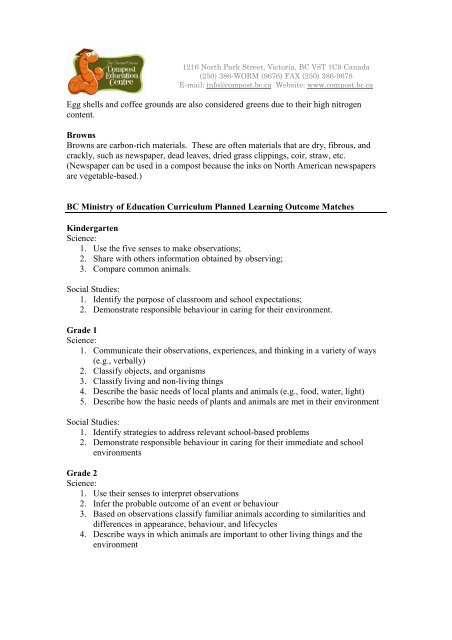Wrigglers At Work Worm Composting Lesson Plan - The Greater ...
Wrigglers At Work Worm Composting Lesson Plan - The Greater ...
Wrigglers At Work Worm Composting Lesson Plan - The Greater ...
Create successful ePaper yourself
Turn your PDF publications into a flip-book with our unique Google optimized e-Paper software.
1216 North Park Street, Victoria, BC V8T 1C9 Canada<br />
(250) 386-WORM (9676) FAX (250) 386-9678<br />
E-mail: info@compost.bc.ca Website: www.compost.bc.ca<br />
Egg shells and coffee grounds are also considered greens due to their high nitrogen<br />
content.<br />
Browns<br />
Browns are carbon-rich materials. <strong>The</strong>se are often materials that are dry, fibrous, and<br />
crackly, such as newspaper, dead leaves, dried grass clippings, coir, straw, etc.<br />
(Newspaper can be used in a compost because the inks on North American newspapers<br />
are vegetable-based.)<br />
BC Ministry of Education Curriculum <strong>Plan</strong>ned Learning Outcome Matches<br />
Kindergarten<br />
Science:<br />
1. Use the five senses to make observations;<br />
2. Share with others information obtained by observing;<br />
3. Compare common animals.<br />
Social Studies:<br />
1. Identify the purpose of classroom and school expectations;<br />
2. Demonstrate responsible behaviour in caring for their environment.<br />
Grade 1<br />
Science:<br />
1. Communicate their observations, experiences, and thinking in a variety of ways<br />
(e.g., verbally)<br />
2. Classify objects, and organisms<br />
3. Classify living and non-living things<br />
4. Describe the basic needs of local plants and animals (e.g., food, water, light)<br />
5. Describe how the basic needs of plants and animals are met in their environment<br />
Social Studies:<br />
1. Identify strategies to address relevant school-based problems<br />
2. Demonstrate responsible behaviour in caring for their immediate and school<br />
environments<br />
Grade 2<br />
Science:<br />
1. Use their senses to interpret observations<br />
2. Infer the probable outcome of an event or behaviour<br />
3. Based on observations classify familiar animals according to similarities and<br />
differences in appearance, behaviour, and lifecycles<br />
4. Describe ways in which animals are important to other living things and the<br />
environment


